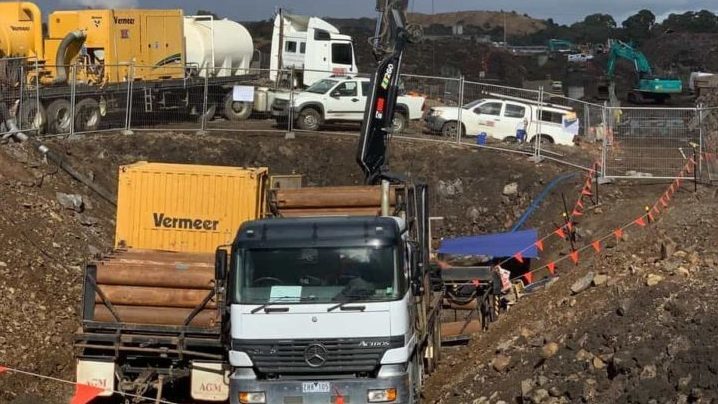When undertaking a pipeline installation using microtunnelling, knowing the prevailing ground conditions on site is imperative for a successful and risk free project. However, it is not uncommon for ground conditions to be different than advised in the geotechnical survey. This increases the risk of an issue arising during the drill, and can make subcontractors wary of taking on a job where challenging conditions are already present.
Edge Underground was contacted by civil engineering company Diona to see if it was willing to undertake a challenging microtunnelling installation in Victoria.
“Diona approached us about a project that had difficult ground conditions that made it very risky to undertake,” Mr Harrison said.
“Other microtunnelling subcontractors had previously been considered for the job, but were not prepared to take it on as it was too big of a risk and they didn’t think it was achievable.
“We had previously worked on a job with Diona in Donnybrook that needed to be completed in a short timeframe, so they knew our capabilities and that we would be able to get the job done.
“This is because we don’t base what we think is achievable based on anyone else other than ourselves. We look at what the conditions are, and knowing our capabilities, we make our own assessment whether we think it is achievable and at what level of relative risk.”
Assessing the ground conditions
Mr Harrison said the company looked at the geotechnical survey provided and knew straight away that it would be a challenging project, but when drilling started, there was a slight difference in the ground conditions experienced.
“As is often the case, the information provided was relatively accurate, but the devil is in the detail, so we didn’t truly see the amount of rock with seams of clay in it, nor the partial fracturing. We didn’t know about this until we started drilling.
“The hardness of the rock was also higher than what was presented in the information.
“It was difficult to work in as the combination of extreme hard rock with seams of clay and the fractures created a hard/soft combination, which creates potential wedging. It’s no surprise that other subcontractors were wary to take it on.”
Completing the job
After assessing the geotechnical survey, Edge Underground set a realistic timeframe to complete the project based on the information provided, and was confident that with its experience and state-of-the-art equipment, the job would be successfully completed.
“We use the Vermeer AXIS laser guided boring system, which has been designed so that the subcontractor doesn’t have to rely on the provided information to be perfectly correct,” Mr Harrison said.
“Other microtunnelling machines are only designed to move forward, so when there is a change in ground conditions, the only way to change to a more suitable drill head is to excavate it from above, which adds time and cost to the project, and increases its risk.
“The Vermeer AXIS does not have this problem as it has the unique ability to retract, allowing us to change the drill head and continue drilling from the same place. It’s a decided advantage.”
Mr Harrison said the project required a 550mm bore, so Edge Underground completed a pilot line before reaming the pipe.
“We pilot and then ream all bores over 350mm, as the pilot line lets us assess the ground conditions and compare our information with the geotechnical information provided,” Mr Harrison said.
“By extracting our own geotechnical sample, we have that as a bore log, giving us a fantastic representation of exactly what the ground conditions experienced on site are.
“Also, because we always complete that initial 350mm pilot, we understand very well how our machine reacts in different conditions.”
Mr Harrison said the information provided by the pilot line allows the company to configure the reaming tool to best suit conditions before pipe jacking, giving the team confidence that it’ll get the job completed.
“We were very aware that the pipeline needed to be installed 12–14m deep, so if we didn’t have this information and part-way through the drive said, ‘Look, I’m sorry, we’re having a few problems, you’re going to have to dig us up’, it would’ve caused a very serious problem,” Mr Harrison said.
“That’s why we firmly believe that the pilot method of verifying conditions really does, to a large extent, eliminate the possibility of needing an emergency retrieval shaft, or what some people call a 911 shaft.
“While it’s not impossible for this to happen when using the AXIS system, it is unlikely, and since we’ve been piloting and reaming, we haven’t had the need to use a 911 shaft.”
Getting the job done
Mr Harrison said Edge Underground is able to complete challenging projects like this because it approaches all projects with a good attitude and a view to find a solution to any challenges that may arise.
“We approached this job like we do all jobs; if there is a job that needs to be done, we’ll get it done,” Mr Harrison said.
“We look at every job as being achievable, it’s just a matter of a finding a way and a means by which you go about achieving that job, that outcome.
“We go out there with a good attitude, and with state-of-the-art equipment, and understand all the different aspects of a job and the complexities, and still find a way to get it done. We pride ourselves on setting a benchmark.”

